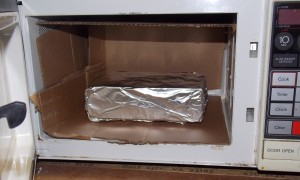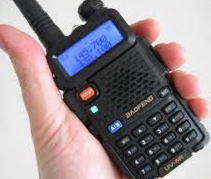 August has been madhouse crazy for us with plenty of work and personal commitments. We have not done as much prepping as I would like. BUT, when we are too busy for physical preps I can always use the time to learn new things. This month’s field of study focused on EMP’s. I found two sites to be particularly informative. The first, The Commission to Assess the Threat to the United States from Electromagnetic Pulse Attack, includes two reports that describe the recommendations for how we should prepare for an EMP strike. It is interesting to read, because you quickly grasp that this report was essentially poo-poo’d by our government and we remain ridiculously unprepared for such an attack. The second is a website that talks about home-made faraday cages designed to protect small electronic devices. After reading this, my son and I built a small faraday cage out of an old microwave; then placed our small shortwave radio inside.
August has been madhouse crazy for us with plenty of work and personal commitments. We have not done as much prepping as I would like. BUT, when we are too busy for physical preps I can always use the time to learn new things. This month’s field of study focused on EMP’s. I found two sites to be particularly informative. The first, The Commission to Assess the Threat to the United States from Electromagnetic Pulse Attack, includes two reports that describe the recommendations for how we should prepare for an EMP strike. It is interesting to read, because you quickly grasp that this report was essentially poo-poo’d by our government and we remain ridiculously unprepared for such an attack. The second is a website that talks about home-made faraday cages designed to protect small electronic devices. After reading this, my son and I built a small faraday cage out of an old microwave; then placed our small shortwave radio inside.
 This month we also made a few purchases. Following Trace and Sarah’s lead, we ordered the Duracell 813-0807 800 Watt DC to AC Digital Power Inverter. For the time being, we have opted not to buy a generator and this will be our interim solution. With three vehicles, we can surely spare one to power some things here at home. My second purchase was a ham radio. We are absolute beginners with ham radios and are not really looking to broadcast (just to receive information from a distance in an emergency), so we opted for a small, inexpensive hand-held model. We ordered the BaoFeng UV-5R 136-174/400-480 MHz Dual-Band DTMF CTCSS DCS FM Ham Two Way Radio, for less than $60. There is a more basic model available, but after reading some reviews we felt this one was a better choice. All that said, even this basic model is a complex item that is going to take some research to understand. Thankfully, there is always the internet and YouTube to answer our questions. And, of course, once we get this thing mastered it will also be going into the faraday cage. Our goal is that eventually all the BOB’s will have either shortwave or ham radios in them as well. I will report back next month on how the ham radio learning is going!
This month we also made a few purchases. Following Trace and Sarah’s lead, we ordered the Duracell 813-0807 800 Watt DC to AC Digital Power Inverter. For the time being, we have opted not to buy a generator and this will be our interim solution. With three vehicles, we can surely spare one to power some things here at home. My second purchase was a ham radio. We are absolute beginners with ham radios and are not really looking to broadcast (just to receive information from a distance in an emergency), so we opted for a small, inexpensive hand-held model. We ordered the BaoFeng UV-5R 136-174/400-480 MHz Dual-Band DTMF CTCSS DCS FM Ham Two Way Radio, for less than $60. There is a more basic model available, but after reading some reviews we felt this one was a better choice. All that said, even this basic model is a complex item that is going to take some research to understand. Thankfully, there is always the internet and YouTube to answer our questions. And, of course, once we get this thing mastered it will also be going into the faraday cage. Our goal is that eventually all the BOB’s will have either shortwave or ham radios in them as well. I will report back next month on how the ham radio learning is going!
Last for this month, I continue to harvest tomatoes as they ripen and can them as tomatoes, salsa or ketchup. We have finally gotten over the real HEAT of the summer here so the garden isn’t quite so “needy” any more. We currently have green onions, cilantro, and baby spinach coming up in containers. These are probably our most eaten/purchased vegetables so we are really enjoying the fruits of our labor at the moment!
How did your month go, and how’s your garden growing?
(Monday: September is National Preparedness Month)

Don’t forget to get your Ham Radio License so that you can practice using the ham radio. There are a lot of classes around that not only teach you in a day what you need to know, but they follow up with the FCC test so you can get your technician class license. Also there are quite a few repeaters here in the Puget Sound area that help expand the range of a handheld. (I listen to and use the WA7HJR repeater (444.650) personally).
David- I just signed up for a class in October, but it’s broken up over several nights, a few hours at a time which is better for my schedule. It’s offered for free by a local club and I discovered there is even a store right by me! Can’t wait!
Great. Another piece of advice I would give is to also study up on the General at the same time if you can. You can take as many of the tests as you want for a single testing price and receiving your general class license allows you access to the airwaves used for long range communications.
I followed your link and read a bit about Faraday cages. Just out of curiosity, I have this old box in the garage that used to be my fathers. It was a spares box for a US Air Force Radar component circa 1960 something. The Box empty probably weighs about 35 pounds and is totally constructed of metal, probably aluminum. Due to the nature of the pieces it stored, do you think it was/is a Faraday cage?
It very well could be an early one or some other type of shielding device. I know pretty much nothing about Air Force/aircraft components but it would sure be interesting to try and research the item. Maybe you could look for some USAF military history buffs or military surplus online that could help you identify it. If you do identify it, shoot as a message back!